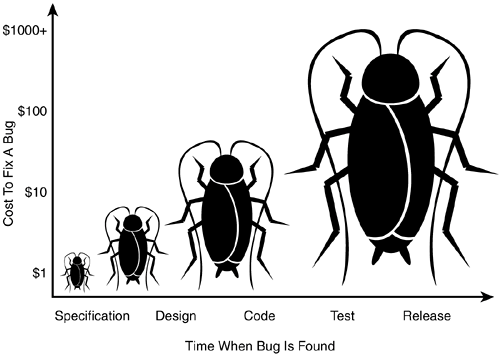Quality Is Free
| Quality is free? Impossible? Nope, it's true. In 1979, Philip Crosby[1] wrote in his book Quality is Free: The Art of Making Quality Certain, that indeed it costs nothing extra (actually it costs less) to produce something of high quality versus something of low quality. Given what you've learned so far about software testing and the work involved in finding and fixing bugs, this may seem impossible, but it's not.
Think back to the graph from Chapter 1, "Software Testing Background," (repeated here as Figure 21.1) that showed the cost of finding and fixing bugs over time. The later bugs are found, the more they costnot just linearly more, but exponentially more. Figure 21.1. There is very little cost if problems are found early in the project.
Now, divide the cost of quality into two categories: the costs of conformance and the costs of nonconformance. The costs of conformance are all the costs associated with planning and running tests just one time, to make sure that the software does what it's intended to do. If bugs are found and you must spend time isolating, reporting, and regression testing them to assure that they're fixed, the costs of nonconformance go up. These costs, because they are found before the product is released, are classified as internal failures and fall mostly on the left side of Figure 21.1. If bugs are missed and make it through to the customers, the result will be costly product support calls, possibly fixing, retesting, and releasing the software, andin a worst-case scenarioa product recall or lawsuits. The costs to address these external failures fall under the costs of nonconformance and are the ones on the right side of Figure 21.1. In his book, Crosby demonstrates that the costs of conformance plus the costs of nonconformance due to internal failures is less than the costs of nonconformance due to external failures. Stomp out your bugs early, or ideally don't have any in the first place, and your product will cost less than it would otherwise. Quality is free. It's common sense. Unfortunately, portions of the software industry have been slow to adopt this simple philosophy. A project will often start with good intentions and then as problems crop up and schedule dates are missed, rules and reason go out the window. Regard for higher future costs is written off in favor of getting the job done today. The trend is turning, however. Companies are now realizing that their cost of quality is high, and that it doesn't need to be. Customers are demanding and their competitors are creating better quality software. Realization is setting in that the words Crosby wrote more than 25 years ago for the manufacturing industry apply just as well to the software industry today. |
EAN: 2147483647
Pages: 233
